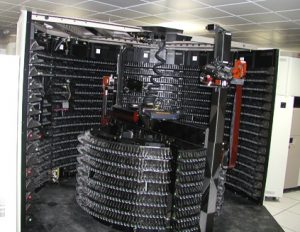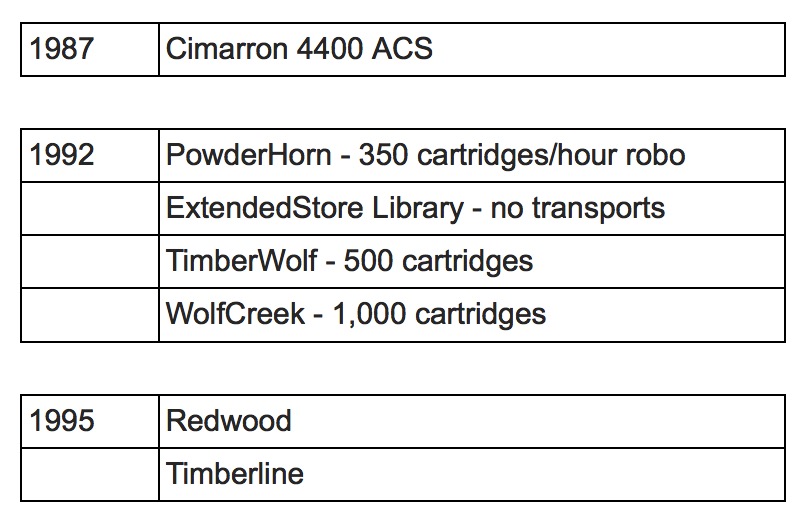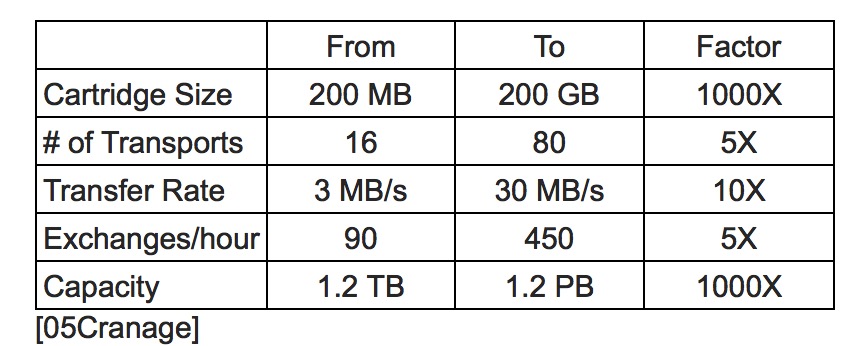History (1987): STK 4400 Automated Tape Cartridge System
Most commercially significant bulk storage subsystem
This is a Press Release edited by StorageNewsletter.com on June 22, 2018 at 2:18 pmThis article comes from WikiFoundry, Inc.
1987: STK 4400 Automated Tape Cartridge System (ACS)
Most commercially significant Bulk Storage subsystem

Why it’s important
Prior to the STK 4400 ACS, Bulk Storage subsystems tended to have limited commercial success and relatively short technological lives. This combination of standardized cartridges and rotary transport mechanism broke through to achieve overwhelming commercial success and was extended through multiple generations.
Discussion:
The term ‘Bulk Storage’ is used generically in this article to describe subsystems which offer online access to substantially more capacity at a lower cost per unit of capacity than that provided by the typical secondary storage devices of high end computing systems.
No matter how much storage has been made directly available to a computer, there has always been a need to access more data e.g. scientific experiments or results of surveys (oil exploration) that generate huge volumes of data are typically ‘mined’ several times after initial use whenever new techniques of analysis are developed.
Data which is seldom accessed and/or huge in volume lends itself well to offline storage and re-loading as necessary to access the data. Since the risk of data loss due to poor management and/or handling has been unacceptable to some applications, online solutions have been developed using various technologies and a number of names (Bulk Storage, Mass Storage Subsystem, Library Storage System, NearLine, etc). The common elements have been removable media, transport mechanisms, and R/W stations.
[The following narrative is chronological]
Within the span of a few years in the 1960’s, three completely different Bulk Storage technologies were introduced to complement and extend the capacity of online storage.
IBM 7955 ‘Tractor’ Tape system
Announced in 1960 the IBM ‘automated tape-cartridge library’ known as the 7955 ‘Tractor’ Tape System was based upon a cartridge of 1.75″ wide tape. Its full capacity was 60 billion characters. The 7955 was integrated with the Harvest special-purpose computer which was peripheral to the Stretch supercomputer. The system was first installed in February 1962 at the National Security Agency for decryption purposes. This may be the first usage of the term ‘library’ in context of a Bulk Storage.
National agencies pushed the envelope when it came to accessing capacity online. IBM pursued the use of film as a medium on the Walnut, which was developed for the CIA. Only six copies of the follow-on 1360 (Cypress) were built, with first delivery in 1967. With 32 chips per cell and 2,250 cells per unit, data capacity was 0.5Tb. Multiple units could be attached to a controller.
NCR CRAM
The 1962 NCR CRAM (Card Random Access Memory) was the first commercial Bulk Storage device. CRAM used 14″ long magnetic mylar cards that were 3.25″ wide, with seven recording tracks. The 256 cards in a removable deck provided a total capacity of 5.5 million characters. Up to sixteen CRAMs could be attached to a 315 mainframe, for a total accessible capacity of 80 million characters. The supportable capacity was as large as the number of removable cartridges that were stored in the machine room.
NCR boasted in a brochure that CRAM offered the capability of online inquiry from remote locations.
IBM 2321 Data Cell
The IBM 2321 introduced in 1964 changed the competitive picture. A ‘puff of air’ was used to separate and select one of 200 magnetic strips enclosed in each data cell. Like CRAM, the strips were wrapped around a drum to be read. Each data cell had a capacity of 40MB and there were 10 per device for a total capacity of 400MB. Since up to eight 2321 devices could be attached to a 2841 controller, the total capacity per subsystem was 3.2GB. Slightly over 1300 2321’s built, all of them in San Jose, CA. A 2321 rented for $2,800 per month and nearly all of them were rented rather than purchased.
Both CRAM and the 2321 were highly profitable programs for their companies. Although there is a low opinion of the 2321 by some of those in the disk drive industry, it pioneered the applications which embraced higher capacity disk drives as they were introduced.
National agencies pushed the envelope when it came to accessing capacity online. IBM pursued the use of film as a medium on the Walnut, which was developed for the CIA. Only six copies of the follow-on 1360 (Cypress) were built, with first delivery in 1967. With 32 chips per cell and 2,250 cells per unit, data capacity was 0.5Tb.
Multiple units could be attached to a controller.
In the following years, Ampex and Grumman competed with IBM on large agency bulk store bids with magnetic tape. The Grumman Masstape system built was built around longitudinal recording on wide tape enclosed in a huge cartridge. With their successful history in audio and video recording, Ampex used transverse recording on 2″ wide tape reels. Ten reels held 0.5Tb, and up to 30 tape drives could be active at a time on a system. Despite being more successful than Grumman, Ampex delivered only six systems to national agencies.
IBM 3850 Mass Storage System
Disk drive technology had become ubiquitous, and the next generation of Bulk Storage took advantage of the software infrastructure. In 1974 IBM announced the 3850 library of 50MB cartridges stored in honeycomb cells, using robotics that ran on longitudinal rails to remove/replace cartridges. From a system’s perspective this subsystem appeared as a set of virtual 3330 disk drives, actual 3330 disk drives were used as staging/destaging devices to load/offload tape data from/to disk. This was the first use of helical scan recording for storage and possibly the first use of virtualization. The 3850 had a long sales life that lasted over a decade but only shipped about 500 units.
Alternatives to the 3850 were developed by Masstor and CDC.
Masstor
Masstor more than tripled the access capacity of the 3850 cartridge, and used robotics that rotated within a cylinder. Each cylinder held close to 0.5Tb. The fact that the Masstor access time and speed were much improved over the 3850 influenced Fujitsu to purchase the company. With sales of of 300 systems on an OEM basis as the M8561 and on Facom systems as the F6460, this was a successful product line for Fujitsu.
CDC 38500
The CDC 38500 was sold against the 3850 on IBM systems, but with a cartridge capacity of only 8MB it was not competitive. The linear cartridge technology was originally developed by IBM under the code name Commanche and was transferred to CDC as part of IBM’s settlement of CDC’s anti-trust lawsuit against IBM. CDC’s supporting software VDAM (Virtual Data Set Access Method) drew praise. Rather than extend the 38500, CDC OEMed the Fujitsu M8561.
The specialized nature of devices developed for Bulk Storage offerings made them expensive, and limited the market size. The first company that tried to change this approach with standard tape drives attempted to do so when the 3850 was nowhere on the horizon. Boulder-based Xytex was founded in the early 70’s by ex-employees who had been unsuccessful in selling the concept of an automated tape library driven by linear robotics to IBM management.
Xytex
Xytex had the right concept, but the product was doomed when Calcomp acquired the company in 1975 and transferred everything to Anaheim. Only nuts and bolts made the journey because the entire development team resigned en masse. Calcomp sold this on to Braegen which managed to resolve the bugs and met with limited market success as the ATL (Automated Tape Library). Fujitsu and Braegen jointly developed the Terabit File Store which included optimized file (volume) placement and disk caching to enhance performance.
StorageTek 4400 ACS
A decade later StorageTek took the concept to new heights by utilizing rotary access robotics (shades of Masstor). Announced in 1987, the Cimarron 4400 ACS (Automated Cartridge System) utilized silos to mechanize access to thousands of 200MB IBM 3480 tape cartridges (introduced in 1985).
StorageTek entered bankruptcy during the development cycle, so then-CEO Ryal Poppa struggled with the creditors who wanted to see expenses reduced. A significant contribution to the eventual success was the insistence on customer involvement in the development cycle. This had the dual effect of building a pre-availability customer list and ensured that the product did not look like something engineering thought the customer wanted.
Media-compatibility with IBM products had been a de facto requirement for tape products until StorageTek used the success of silo automation to introduce a new cartridge in 1995. Redwood’s helical scan recording technology was developed by Panasonic and incorporated in a cartridge jointly developed by 3M and StorageTek. At 50GB it was then the world’s largest capacity tape cartridge. Helical scan always had to be carefully maintained but the high price compared to standard cartridge products was ultimately the biggest challenge for Redwood.
StorageTek provided a continuous series of upgrades in cartridge capacity, drive attachments, picker performance, etc.

Over a span of 20 years an original ACS with 6,000 slots has been enhanced:

Partnerships with other manufacturers took the ACS outside the realm of an IBM-only product to the point of being able to share silos between multiple OSs and heterogeneous computer complexes.
The success of ACS influenced the entire removable media market. ACS ‘destroyed’ the utility of stand-alone tape drives, and that effect trickled down rapidly.
Smaller variations to support all forms of tape and optical media became known as jukeboxes, and standardized generic software capable of supporting multiple library/jukebox types under different OSs fueled the acceptance. Barcoding resolved the problem of media stored in the ‘wrong’ location, because it could be identified and re-located as needed.
Online Bulk Storage has become ubiquitous as a technology that provides automated access to almost any kind of low-cost removable media, be it magnetic or optical. Disk drives have been long used as a means to cache removable media data for improved performance, but the huge volumes of the PC market have dropped the cost to a point where online Bulk Storage offerings need no longer be based on removable media.
Bulk Storage may have had its origins as a unique product justified by data mining applications, but it has become mainstream and is now looked upon as just one of the cost alternatives in the storage hierarchy.
Provenance note:
This article was written by Dal Allan. It was reviewed and approved by the Computer History Museum’s Storage SIG on July 21, 2011 and posted at the museum’s website as NCR CRAM and STK 4400 Automated Cartridge System.













 Subscribe to our free daily newsletter
Subscribe to our free daily newsletter

